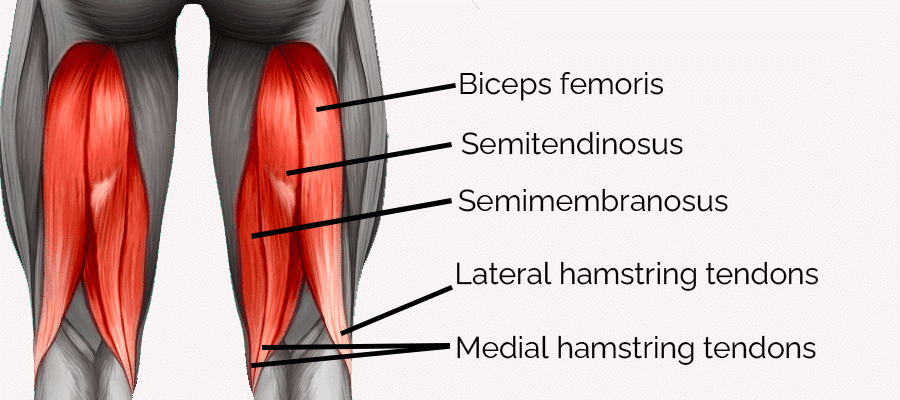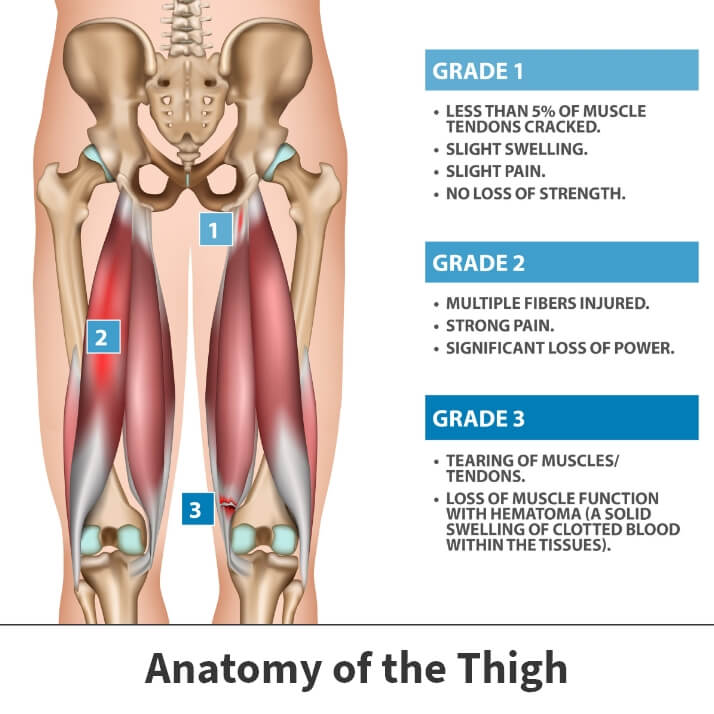Hamstring Exercises for Athletes

Strong hamstrings are your secret weapon for peak performance. They’re the powerhouse behind swift sprints, explosive jumps, and resilient legs that can take on miles of trails without flinching. By focusing on these muscles, you’re not just building strength; you’re bulletproofing your body against injury.
Lets dive into hamstring workouts tailored for athletes looking to level up their game. You’ll get the lowdown on anatomy essentials—because knowing why matters as much as how—and learn safe warm-up practices to keep those injuries at bay.
We’ve got a lineup of must-try moves from sprints for glutes and other hammie workouts that will supercharge your hamstring training from basic stretches to advanced drills designed for hardcore fitness buffs ready to push limits.
Why Hamstrings Workouts Matter
Hamstrings—the divas at the back of our thighs that demand attention but are often neglected until they start screaming during a hike or when we’re trying to beat our personal best on a run. But are they really that important? Surely just regular running or backpacking gives these prima donnas enough exercise without warranting more of our precious time in the gym or on the trail? And how do they even connect with our core and glutes anyways? Let’s explore these questions and more and discover the true importance some good old-fashioned strength training and stretching can really have on these leg muscles.
How Hamstrings Do The Heavy Lifting
If you think about it, hamstrings are like that friend who helps you move—they do all this heavy lifting but only get noticed when something goes wrong. These muscles play a starring role in just about every leg movement, from running up hills to squatting down to set up camp. They help propel us forward and control our speed as we descend slopes; without them, well, we’d be going nowhere fast—or gracefully.
A strong hamstring trio can mean the difference between an enjoyable day on the trails and one spent wondering why every step feels like torture. It’s not just for kicks either; the Florida Orthopedic Institute on hamstring injury prevention shows that hamstring strength is key in preventing injuries, especially those pesky ACL tears nobody wants as souvenirs from their outdoor adventures.
The Anatomy of Hamstrings
The hamstrings aren’t just one muscle—they’re three separate ones working together like a well-oiled machine (when properly cared for). We’ve got biceps femoris playing lead guitar with semitendinosus and semimembranosus as backup vocals—harmonizing to bend your knee and extend your hip so you can leap over logs or bound uphill with ease.

This trifecta doesn’t act alone though; it’s part of an ensemble cast featuring glutes and core muscles ensuring stability. So no skipping out on giving them proper hamstring strength exercise or you’ll setting yourself up for potential disaster (or at least discomfort).
Pre-Workout Hamstring Warmup
You wouldn’t expect performers to hit high notes without warming up first—and same goes for those hammies before putting them through their paces. A solid warm-up session primes those muscles making sure they don’t pull any unwelcome stunts mid-performance… I mean workout.
- Gentle dynamic stretches let ‘em know showtime is coming,
- Movement patterns specific to hiking prep them for what’s ahead,
- And foam rolling? Think of it as a self-massage to ease muscle tightness. It can really help, especially after a tough workout.
Hamstrings are the unsung heroes of leg day, working hard behind the scenes to power every step and jump. Don’t wait for pain to give them a nod; strengthen and stretch your hammies regularly to prevent injuries and improve performance.
Think of warming up your hamstrings as a pre-show ritual; dynamic stretches, hiking-specific movements, and foam rolling get them ready for action without any drama.
The Dynamic Duo: Core and Glutes Synergy
If you think hamstrings are all about solo performance, think again. They love teaming up with their neighbors—the core and glutes—to form an alliance stronger than any supergroup out there (sorry Avengers). When your hammies sing in harmony with your core stabilizers and those peachy butt muscles during exercises like deadlifts, they help keep everything from posture to lifting technique sharper than a tack—or should I say trekking pole?
This dynamic collaboration isn’t just good news for looking fab at beach volleyball; it translates into better control over rugged terrains because let’s be real—who wants wobbly legs halfway up Mount Everest? So if you thought skipping hamstring day was no biggie…think again.
Road Map To Injury-Free Adventures
Seriously though, neglecting hamstring training is akin to forgetting toilet paper on a camping trip—it won’t end well. These muscles are notorious divas prone to injury if not treated right because tightness plus sudden movements equals disaster movie starring YOU as both protagonist AND victim. That’s why working them out regularly is more important than perfecting that s’mores recipe.
And let me tell ya’, strong hamstrings mean fewer injuries which translate directly into less time whining on the couch—and more time conquering peaks or chasing sunsets across endless horizons.
Hamstring Injuries And How to Recognize
There are three grades of hamstring injuries accepted by almost all medical professionals.
- Grade 1: This is your “oopsie daisy” of hamstring injuries. Picture it as a minor hiccup in your stride, a slight pull that whispers, “Maybe we should’ve warmed up first, huh?” You’ll feel a bit of discomfort, perhaps a gentle reminder of your mortality, but you’ll still fancy yourself as the weekend warrior. It’s like your muscle is sending you a text message saying, “I’m not mad, just disappointed.”
- Grade 2: Now we’re getting into the “Oh, I definitely felt that” territory. Imagine your muscle fibers throwing a partial tantrum, ripping apart just enough to make you reconsider all your life choices that led to this moment. You’ll experience pain, the kind that makes you wince and possibly invent new dance moves. Swelling and bruising appear as unsolicited artwork on your leg, a visible sign you’ve graduated from mere discomfort to genuine “ouch” territory. It’s the muscle’s way of saying, “Told you so.”
- Grade 3: Welcome to the “I guess I’m becoming one with the couch” phase. This is the full-blown, dramatic finale of hamstring injuries, where your muscle fibers decide to part ways completely. Walking becomes an activity as likely as winning the lottery, accompanied by pain so intense it could be its own opera. The swelling and bruising are so dramatic; they deserve their own Instagram account. At this point, your hamstring isn’t just mad; it’s plotting its revenge. It’s the kind of injury that makes you question why you ever left the bed in the first place.
Preparing for Hamstring Workouts
Warming up your hamstrings is like preheating an oven before you throw in a pizza—it’s just common sense. You wouldn’t toss a cold, stiff pie into the heat and expect gourmet results, right? The same goes for your muscles.
The Art of the Warm-Up
So, let’s talk about activating those hammies. First things first: A dynamic warm-up can save you from snapping something important when you’re trying to show off at the gym or on the trail. And nobody wants that. Try some leg swings to get blood flowing; they’re simple and strangely satisfying—like popping bubble wrap with your legs.
A good set of high knees will also do wonders—not only does it sound like a dance move from the ’80s but it actually gets those hamstrings ready for action by simulating running movements without all that pesky forward motion.
Form Matters
Buckle up because we’re going hardcore mom-mode on form here. When hitting hamstring exercises, proper technique isn’t just important—it’s everything. So picture this: every time you perform an exercise with poor form, somewhere out there a personal trainer sheds a single tear.
If deadlifts are part of your plan—and why wouldn’t they be—they need to be as spot-on as sending back soup at a fancy restaurant because there was “a fly” in it (we know there wasn’t). Keep that back straighter than an arrow shot by Legolas himself.
Mind-Muscle Connection
You’ve probably heard someone talking about mind-muscle connection while sipping their organic kale smoothie—but guess what? It’s legit. Visualizing yourself crushing those hamstring curls helps more than pretending not to notice someone else using the machine wrong… again.
Focusing intently on each rep ensures maximum muscle engagement and keeps wandering thoughts—like what’s for dinner—from stealing reps’ effectiveness faster than cookies disappear at fat camp.
Focused hamstring Stretching
No matter how tough or bendy you think you are, stretching matters—a lot. Think Gumby meets Arnold Schwarzenegger; now channel that image while doing stretches. Good old-fashioned toe touches come into play here; reach down like you dropped winning lottery tickets between your feet, but please don’t rush through them faster than people flee work on Fridays.
After a heavy workout, sometimes you just want to relax. In that case, consider static stretching as your go-to cool-down. This involves holding a stretch for 20-30 seconds, allowing your muscles to loosen up gradually. It’s not only good for recovery; it also improves flexibility over time.
Hamstring Strengthening Exercises
You know how you feel when you finally reach the summit after a grueling hike? Your hamstrings are singing—or more like screaming—a tune of exhaustion. It’s high time we give those hardworking muscles some love with exercises that’ll make them as tough as your trail-snacking habits.
The Classic Deadlift
Sure, picking things up and putting them down seems simple enough—until it’s a barbell loaded with weights. The deadlift is the ultimate test of raw strength and one of the best ways to beef up your hammies. Keep your back straight, bend at the hips, grip that bar like it owes you money, lift with power from your legs, then stand tall feeling like Hercules.
Now listen here; form is everything unless you’re aiming for an all-expenses-paid trip to Snap City (not recommended). So do yourself a favor and check out proper deadlifting techniques. Trust me; watching these videos beats learning through spine-tingling trial-and-error any day.
Romanian Deadlifts
If regular deadlifts had a cousin who was cool but slightly intimidating—that would be Romanian Deadlifts (RDL). These bad boys isolate the hamstrings even more by keeping your legs almost straight throughout. Start lighter than you think because ego lifting leads to nothing but tears and ice packs. Here’s where control trumps weight—you’re not auditioning for ‘World’s Strongest Person’; slow and steady wins this race.
Honestly though, why take my word for it when there’s plenty of guidance online? Peek at this tutorial on RDL technique, so next time someone asks about RDLs in casual conversation (because doesn’t everyone?), you can flex both knowledge and muscle.
Lying Leg Curls
Sometimes lying down while working out feels just right—enter lying leg curls. This exercise lets gravity sit this round out while focusing on hamstring contraction through resistance machine magic or bands if home workouts are more your jam—but don’t get too comfy now. You need controlled movement here too—not jerky motions reminiscent of a fish flopping around on land.

Deadlifts and Romanian Deadlifts are your go-to for solid hamstrings. Keep that back straight, lift smart, and say no to Snap City with proper form.
Flexibility and Mobility Work for Hamstrings
Oh, the hamstrings – those divas of the lower body. They demand attention, don’t they? If you’ve ever tried to reach down and touch your toes only to be rudely stopped halfway by tight hamstrings, you know what I’m talking about. So let’s talk shop on how to give these prima donnas what they need: a good stretch.
The Stretching Symphony
Sure, you could just plop down and hope for the best as you aimlessly reach toward your ankles. But where’s the finesse in that? Instead, try some dynamic stretches before moving into static holds – it’s like warming up an orchestra before hitting that high note.
Start with leg swings because nothing says ‘I’m getting ready’ quite like almost kicking yourself in the face. You can do them front-to-back or side-to-side; just make sure there’s no one nearby unless you’re looking to start a fight club.
After those swings get blood pumping through your legs faster than caffeine does through your veins at 6 AM on a Monday morning,
Yoga Pigeon Pose
If pigeons can do it without any hamstring drama, so can we – right? This yoga classic isn’t just showing off flexibility; it gets deep into those hammies while also saying hello to your glutes and hip flexors.
Pigeon pose, here we come. Ease into this position gently; if there are popping sounds, back off unless sound effects are part of your stretching routine.

Incorporating Hamstring Exercises into Your Routine
So you want to give your hamstrings some love, huh? Great idea—because those bad boys are the unsung heroes of leg day. Let’s get real: neglecting them is like trying to hike up a steep trail with one boot missing. You might make it, but it won’t be pretty.
Timing Is Everything
You’ve got a busy life; we get it. Between brewing your artisanal coffee and perfecting your wilderness selfie game, who has time for another workout? Here’s a secret: hamstring exercises can sneak into any routine faster than an uninvited critter in your tent at night. Just pick two days a week—you know, the ones where you don’t climb mountains or conquer trails—to focus on those hammies.
Maybe mix them in on upper-body days because believe it or not, balance matters outside of yoga class too. Or tack them onto core workouts since strong hamstrings will help keep that backpack from tipping you over backwards down hills—which isn’t as funny as it sounds.
The “Anywhere” Moves
Surely there’s no gym out in the wilds—or maybe there is and we just haven’t gotten the memo yet. For now though let’s talk about moves that need zero equipment unless you count rocks and logs lying around (which could totally work if you’re feeling adventurous).
Nordic curls are gold—they’ll turn those hams into steel cables ready to power through miles of rugged terrain without so much as a whimper like studies suggest they do wonders for strength gains. Find something sturdy to anchor your feet under—a tree root perhaps—and lower yourself gracefully…or just try not falling flat on your face until you master this one.
Fitting In Flexibility Work
If flexibility wasn’t important, jeans would never have evolved past 1980s denim—that stiff-legged walk isn’t cute anymore folks. Stretching out after hiking all day makes sure tomorrow doesn’t feel like punishment by muscle cramps. While enjoying nature’s serenity post-hike wrap-up with standing single-leg hamstring stretches against trees or seated toe-touches right there on mother earth’s floor mat.
It only takes minutes but pays off big time when leaping across streams becomes less ‘leap’ more ‘glide’. Remember dynamic stretching before hitting the trail can prep muscles better than caffeine does morning moods.
Advanced Hamstring Training Techniques
If you think your hamstrings are already as tough, wait until you try some of these advanced techniques. These aren’t for the faint of heart or those who consider a brisk walk to the fridge their daily exercise routine.
Eccentric Overload for Unstoppable Hamstrings
Sure, concentric moves are cute and all, but if you want hamstrings that could stop traffic (because let’s face it, everyone will be staring at your legs), then eccentric exercises like Nordic hamstring curls are where it’s at. Eccentric loading focuses on lengthening the muscle under tension—think controlling the descent in a deadlift—and research shows this can lead to significant strength gains.
Don’t just drop like a sack of potatoes though; control is key here. Start with fewer reps because trust me; your muscles will feel like they’ve run a marathon backward uphill while wearing ankle weights by the end.
Plyometrics: Powerhouse Your Hammies
We’re not talking about skipping around happily in a field of daisies. We’re talking explosive box jumps and depth jumps that’ll make your hamstrings snap to attention faster than an army recruit first thing in the morning. Not only do plyometric exercises build power—they also increase muscular endurance, so you can hike up mountains without feeling like your legs have turned into jelly.
Remember: land softly unless you enjoy knee pain, which I doubt anyone does outside of masochists perhaps?
Resistance Bands For Hikers On The Go
No weights? No problem. Grab yourself some resistance bands—the unsung heroes when it comes to hamstring development—and get ready for leg curls that’ll leave even Hercules envious.
You might look slightly ridiculous pulling against what essentially looks like an oversized rubber band—but hey, looking cool is secondary when we’re sculpting Greek-god-like lower limbs here.
Note: Always remember proper form trumps everything else—even eagerness to become part-human-part-springbok through plyometrics or using resistance bands strong enough to tow trucks. Safety first. And maybe invest in quality resistance bands unless breaking one mid-exercise and getting snapped back into reality (quite literally) sounds appealing? Just food for thought.
Now go forth with these advanced training tips tucked snugly under your belt. Ready to tackle your goals, remember that consistency is key. Keep pushing yourself, stay focused on your objectives, and watch as you surpass even your own expectations.
Conclusion
Mastering hamstring exercises is the game-changer for athletic prowess. Remember, it’s all about power and injury prevention.
Start with knowledge; know your hamstrings inside out. Warm up smart to keep harm at bay. Dive into strengthening routines that challenge you.
Flexibility can’t be overlooked—it’s the key to full motion and strain dodging. Weave these workouts into your daily grind for unstoppable legs on every trail.
Pursue advanced techniques when you’re ready to up the ante—your hamstrings will thank you as they grow stronger and more agile than ever before.
If today’s deep dive has revved up your readiness for robust leg days, then lace up those sneakers—it’s time to hit new personal bests!







